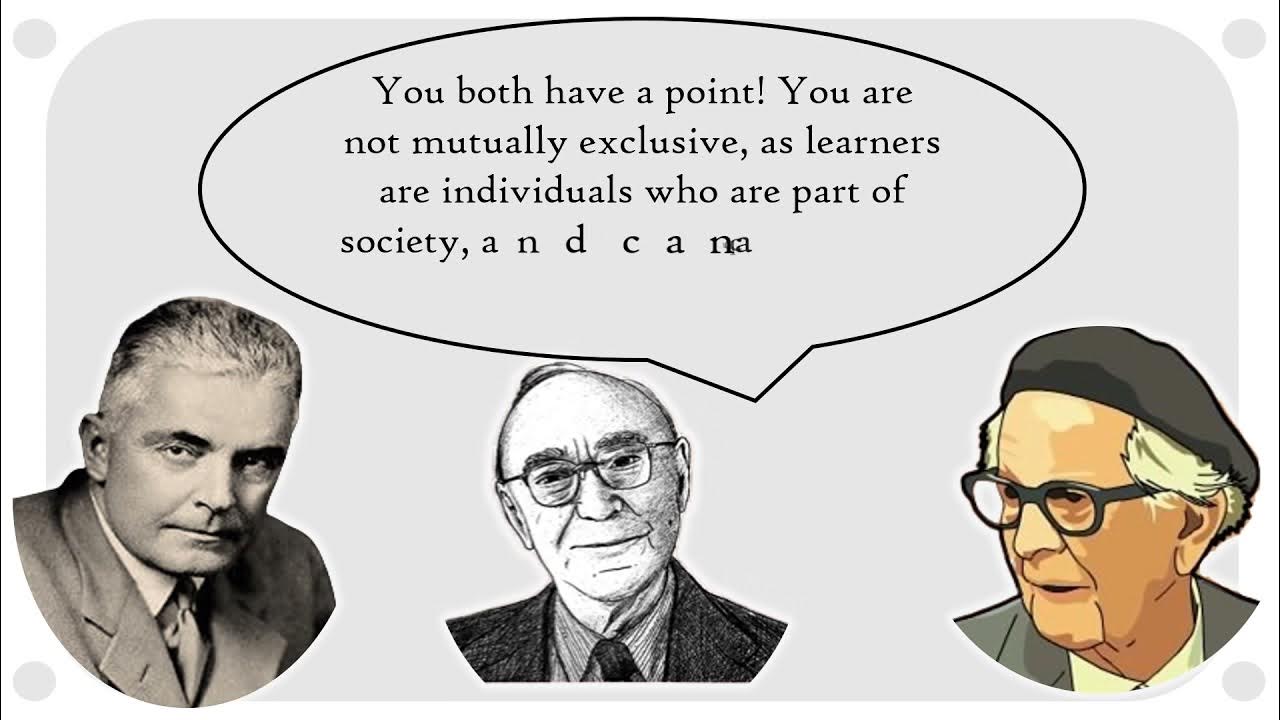Behaviorism, Cognitivism, Constructivism & Learning and Instructional Theory
Summary
TLDRThis educational video script explores three perspectives on learning: behaviorism, cognitivism, and constructivism. Behaviorism sees learning as regular responses to stimuli, emphasizing repetition and reinforcement. Cognitivism views the mind as a computer, focusing on attention, comprehension, and recall. Constructivism likens the mind to a web, where learning is knowledge construction through active engagement. The script differentiates between descriptive theories, which explain learning, and prescriptive theories, which guide instructional methods to foster learning.
Takeaways
- 🔍 Primer theories provide different perspectives on learning and instruction.
- 🧠 Behaviorism views the mind as a black box, focusing on observable behaviors and regular responses.
- 💻 Cognitivism sees the mind as a computer, emphasizing the recall and storage of information.
- 🏗️ Constructivism considers the mind as a network, where learning involves building and connecting knowledge.
- 🔄 Behaviorism emphasizes repetition and reinforcement as key to learning.
- 🎯 Cognitivism stresses the importance of attention and making sense of information for learning.
- 🛠️ Constructivism advocates for guided problem-solving as a method of instruction.
- 📚 Descriptive theories in education aim to answer 'What is learning?'.
- 📈 Prescriptive theories, or instructional theories, answer 'How do we help people learn?'.
- 🔑 The three perspectives—behaviorism, cognitivism, and constructivism—shape both descriptive and prescriptive theories of learning.
Q & A
What is the main idea behind the concept of 'theories' in the context of the provided transcript?
-Theories are likened to windows in a house, offering different viewpoints or perspectives on the same subject, in this case, learning and instruction.
How does behaviorism view the mind?
-Behaviorism views the mind as a black box, focusing on observable behaviors and regular, expected responses as indicators of learning.
What is the primary method of instruction according to behaviorism?
-Instruction according to behaviorism involves repetition and reinforcement to help people learn and develop.
How does cognitivism differ from behaviorism in its view of the mind?
-Cognitivism views the mind as a computer, emphasizing the recall and storage of information as evidence of learning.
What is the role of attention and sense-making in cognitivist instruction?
-In cognitivist instruction, the focus is on grabbing the learner's attention and helping them make sense of information for later recall.
What is constructivism's perspective on the mind and knowledge?
-Constructivism views the mind as a network of interconnected nodes, where skills and knowledge are built upon and accessed as needed.
How does constructivist instruction approach problem-solving?
-Constructivist instruction involves guiding learners in solving new and ill-defined problems, fostering knowledge construction through active engagement.
What is the difference between descriptive and prescriptive theories in education?
-Descriptive theories, or learning theories, aim to describe what learning is and how it occurs, whereas prescriptive theories, or instructional theories, provide methods for fostering learning.
What question does descriptive theory help to answer in the context of education?
-Descriptive theory helps to answer the question 'What is learning?' by attempting to describe the nature and process of learning.
What question does prescriptive theory address in educational settings?
-Prescriptive theory addresses the question 'How do we help people learn?' by offering instructional methods and strategies.
How do the three perspectives—behaviorism, cognitivism, and constructivism—contribute to our understanding of learning and instruction?
-These perspectives provide different frameworks for understanding how learning occurs and how it can be facilitated, offering complementary approaches to instructional design.
Outlines

Dieser Bereich ist nur für Premium-Benutzer verfügbar. Bitte führen Sie ein Upgrade durch, um auf diesen Abschnitt zuzugreifen.
Upgrade durchführenMindmap

Dieser Bereich ist nur für Premium-Benutzer verfügbar. Bitte führen Sie ein Upgrade durch, um auf diesen Abschnitt zuzugreifen.
Upgrade durchführenKeywords

Dieser Bereich ist nur für Premium-Benutzer verfügbar. Bitte führen Sie ein Upgrade durch, um auf diesen Abschnitt zuzugreifen.
Upgrade durchführenHighlights

Dieser Bereich ist nur für Premium-Benutzer verfügbar. Bitte führen Sie ein Upgrade durch, um auf diesen Abschnitt zuzugreifen.
Upgrade durchführenTranscripts

Dieser Bereich ist nur für Premium-Benutzer verfügbar. Bitte führen Sie ein Upgrade durch, um auf diesen Abschnitt zuzugreifen.
Upgrade durchführenWeitere ähnliche Videos ansehen

Big 3 Learning Theories: Behaviorism, Cognitivism, Constructivism! Intro to ID Part 4 of 6

THEORIES OF LEARNING: BEHAVIORISM, COGNITIVISM, & CONSTRUCTIVISM

The 5 Learning Theories

Introduction to Learning Theories

Learning Theories 2022 | Behaviorism | Cognitivism | Constructivism |

Learning Theory and Online Course Design
5.0 / 5 (0 votes)
